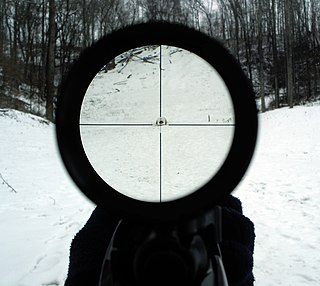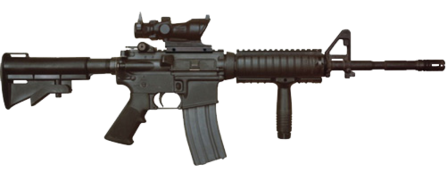
The M16 rifle is a family of military rifles adapted from the ArmaLite AR-15 rifle for the United States military. The original M16 rifle was a 5.56×45mm automatic rifle with a 20-round magazine.

The M4 carbine is a 5.56×45mm NATO, gas-operated, magazine-fed carbine developed in the United States during the 1980s. It is a shortened version of the M16A2 assault rifle.

A reticle, or reticule also known as a graticule, is a pattern of fine lines or markings built into the eyepiece of an optical device such as a telescopic sight, spotting scope, theodolite, optical microscope or the screen of an oscilloscope, to provide measurement references during visual inspections. Today, engraved lines or embedded fibers may be replaced by a digital image superimposed on a screen or eyepiece. Both terms may be used to describe any set of patterns used for aiding visual measurements and calibrations, but in modern use reticle is most commonly used for weapon sights, while graticule is more widely used for non-weapon measuring instruments such as oscilloscope display, astronomic telescopes, microscopes and slides, surveying instruments and other similar devices.

A telescopic sight, commonly called a scope informally, is an optical sighting device based on a refracting telescope. It is equipped with some form of a referencing pattern – known as a reticle – mounted in a focally appropriate position in its optical system to provide an accurate point of aim. Telescopic sights are used with all types of systems that require magnification in addition to reliable visual aiming, as opposed to non-magnifying iron sights, reflector (reflex) sights, holographic sights or laser sights, and are most commonly found on long-barrel firearms, particularly rifles, usually via a scope mount. Similar devices are also found on other platforms such as artillery, tanks and even aircraft. The optical components may be combined with optoelectronics to add night vision or smart device features.

The Squad Advanced Marksman Rifle (SAM-R) is a semi-automatic designated marksman rifle developed and used by the United States Marine Corps. It gave users the capability to provide fire in support of a rifle squad, providing precision fire in support of an assault, and aid in observation and adjusting of supporting arms.

The Sight Unit Small Arms, Trilux, or SUSAT, is a 4× telescopic sight, with tritium-powered illumination utilised at dusk or dawn. The full name of the current model is the SUSAT L9A1. The sight is not designed as a sniper sight, but is rather intended to be mounted on a variety of rifles and to be used by all infantrymen. A similar device is the Advanced Combat Optical Gunsight (ACOG).

The Squad Designated Marksman Rifle (SDM-R) is an American designated marksman rifle used by the United States Army. It is essentially a heavily modified M16 rifle designed to provide U.S. Army designated marksmen greater accuracy and firepower at longer ranges, increasing an infantry squad's effective range to up to 600 meters.

A designated marksman rifle (DMR) is a modern scoped high-precision rifle used by infantry in the designated marksman (DM) role. It generally fills the engagement range gap between a service rifle and a dedicated sniper rifle, at around 300–600 metres (330–660 yd).

Trijicon, Inc. is an American manufacturing company based in Wixom, Michigan, that designs and distributes sighting devices for firearms including pistols, rifles and shotguns. Trijicon specializes in self-luminous optics and night sights, mainly using the low-energy tritium illumination, light-gathering fiber optics and battery-powered LED.

The C79 optical sight (SpecterOS3.4x) is a telescopic sight manufactured by Elcan. A variant, the M145 Machine Gun Optic is in use by the US military. It is 3.4×28, meaning 3.4x magnification, and a 28mm diameter objective lens. A tritium illuminated reticle provides for normal and low-light conditions sighting. It can be mounted to a variety of rifles and light machine guns using the Picatinny rail mounting system or the similar Diemaco rail system found on small arms produced by Diemaco/Colt Canada. Similar rifle sights are the Sight Unit Small Arms, Trilux (SUSAT) and the Advanced Combat Optical Gunsight (ACOG).
The SS2 is a replacement for the Pindad SS1 created by Pindad. It had been seen during the ASEAN Army Rifles contest by foreign media in 2006 aside from exposure by local Indonesian media.

The M27 Infantry Automatic Rifle (IAR) is a 5.56mm, select-fire assault rifle, based on the HK416 by Heckler & Koch. It is used by the United States Marine Corps (USMC) and is intended to be issued to all infantry riflemen as well as automatic riflemen. The USMC initially planned to purchase 6,500 M27s to replace a portion of the M249 light machine guns employed by automatic riflemen within Infantry and Light Armored Reconnaissance Battalions. Approximately 8,000–10,000 M249s will remain in service with the Marine Corps to be used at the discretion of company commanders. In December 2017, the Marine Corps announced that it would equip every member of an infantry squad with the M27, supplanting the M4 carbine which would be retained at the platoon leadership positions and above.

A red dot sight is a common classification for a non-magnifying reflector sight that provides an illuminated red dot to the user as a point of aim. A standard design uses a red light-emitting diode (LED) at the focus of collimating optics, which generates a dot-style illuminated reticle that stays in alignment with the firearm the sight is attached to, regardless of eye position.

The AN/PAS-13B Thermal Weapon Sight (TWS) is an infrared sight developed for the United States military by Raytheon. The sight is designed for use on small arms in the U.S. military's inventory, but it can also be used as a standalone observation device. The AN/PAS-13B uses thermal imaging so that it can be used day or night. Thermal imaging also allows the sight to see through smoke or fog, things that may normally obscure other night vision devices. The AN/PAS-13 first became operationally capable with the U.S. Army in 1998 and has reached a total production of 33,400 units.

A collimator sight is a type of optical sight that allows the user looking into it to see an illuminated aiming point aligned with the device the sight is attached to, regardless of eye position. They are also referred to as collimating sights or "occluded eye gunsight" (OEG).

1P78-1 & -2 is a telescopic sight manufactured by Novosibirsk Instrument-Making Plant and in use with the Russian Armed Forces, intended as a replacement for the older 1P29 scopes currently being used by the Russian military. The optic is intended to become the standard issue sight for the infantry riflemen on the AK-74M (1P78-1), RPK-74M (1P78-2), and the PKP within the Russian military.

A prism sight or prismatic sight, sometimes also called prism scope or prismatic scope, is a type of telescopic sight which uses a reflective prism for its image-erecting system, instead of the series of relay lenses found in traditional telescopic sights. The use of prisms makes it possible to construct a shorter and lighter sight, or with an offset between the eyepiece and objective axes.

The Elcan Specter is a line of multi-role prism sights created by Raytheon ELCAN Optical Technologies originally designed for M16/M4 family of rifles but now also exists for light machine gun and heavy machineguns. Most of the optics are capable of switching between magnifications and illumination.

























